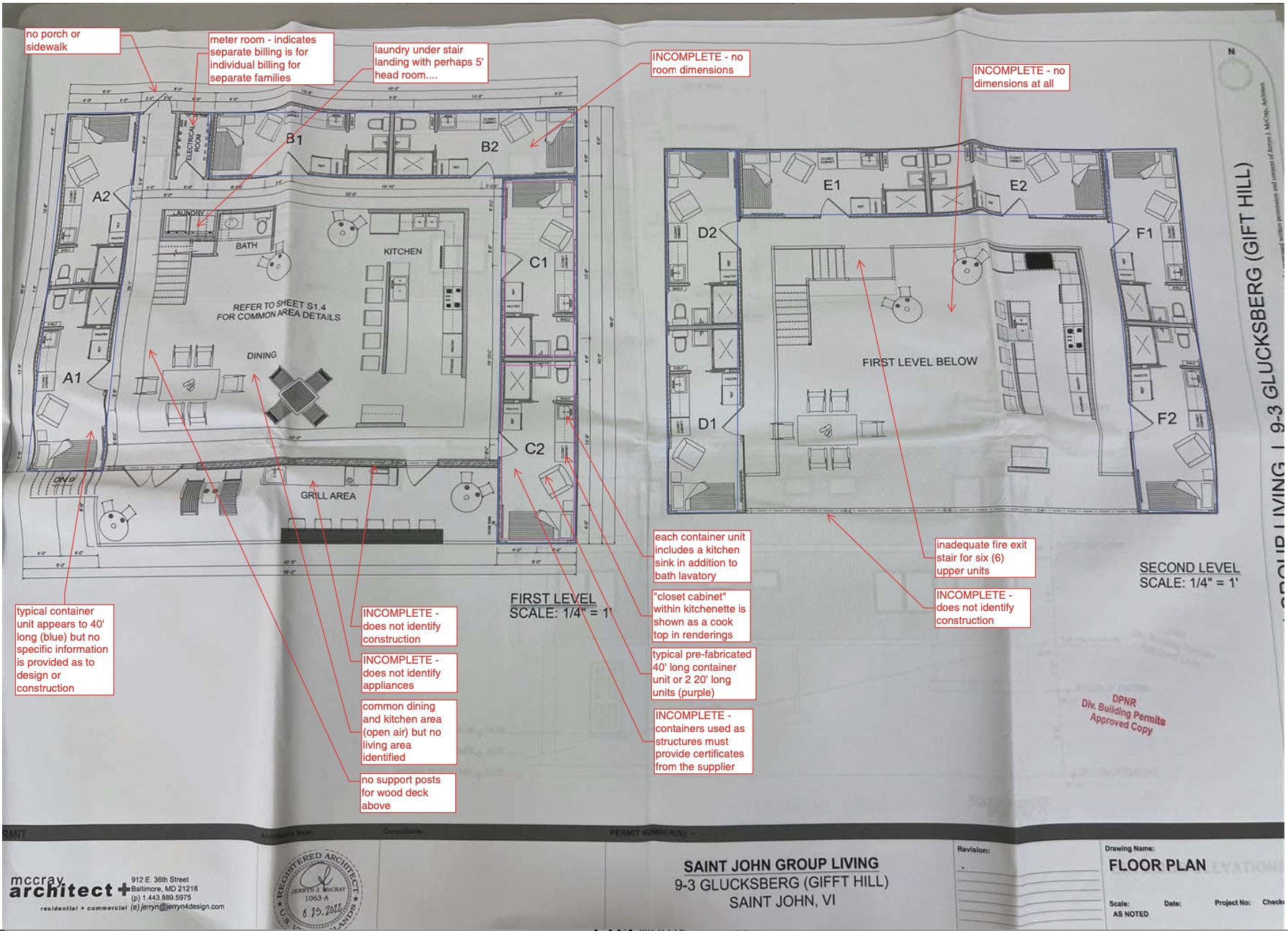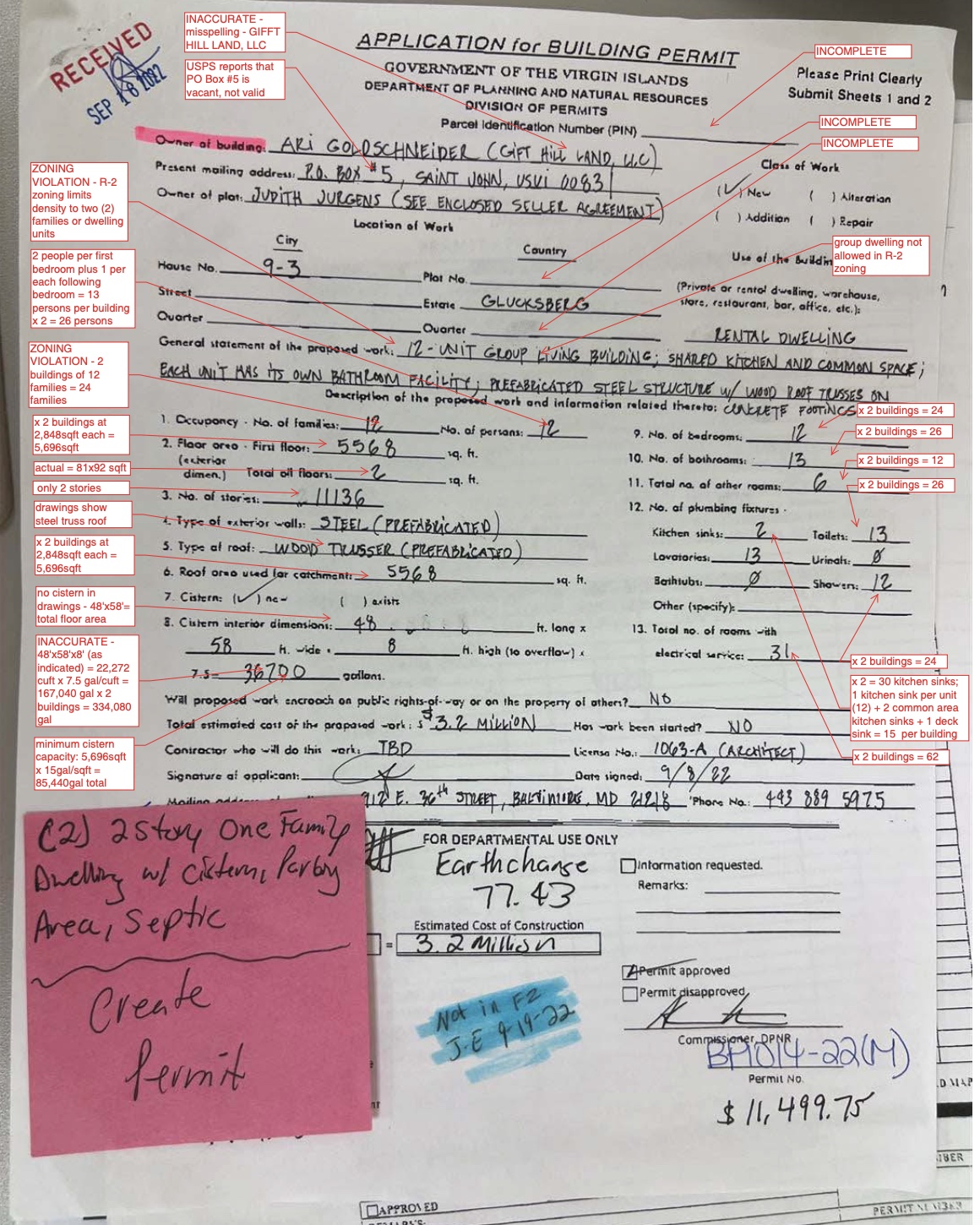Solving the Virgin Islands’ housing shortage will require innovative thinking, but a long-time St. John architect said Tuesday the proposed project at Gifft Hill was flawed beyond its novel shipping container building materials.
Michael Milne of Barefoot Design Group successfully petitioned the Board of Land Use Appeals to temporarily stop excavation and construction at the Estate Glucksberg hillside in mid-July after reviewing building plans and permits that he said were riddled with errors and omissions.
But work didn’t immediately stop. Developer Gifft Hill Land LLC continued pouring concrete, Milne said.

Department of Planning and Natural Resources Commissioner Jean-Pierre Oriol said Tuesday the concrete pours were to stabilize the site conditions “as opposed to exposed earth.”
Milne contended the pours were for cisterns that don’t comply with plans submitted to DPNR land-use reviewers. Once concrete was poured, he said, regulators were unlikely to ask that it be torn back up.
“I mean, bottom line is this permit got pushed through one way or another. I don’t know if they leaned on DPNR or if DPNR just doesn’t care, but it, you know, they ignored their own requirements for construction. They ignored the law and they basically gave this guy a huge gift by giving him permits,” he said. “There’s just so much wrong with this.”
Reached by telephone Tuesday, Ari Goldschneider, owner of Gifft Hill Land LLC, declined to comment on the project or controversy. Goldschneider, owner of Boston-based Goldschneider Properties LLC and a rental villa in Chocolate Hole, is author of the 2017 31-page booklet Multifamily Property Investing Basics.
In a Jan. 12 social media post, Goldschneider thanked St. John Administrator Shikima Jones-Sprauve “for guidance on how to navigate these governmental organizations and sometimes providing a polite phone call to a department to move the process along.” Two weeks later, he told St. John reporters he’d worked closely with DPNR and the Department of Public Works on the designs and engineering, and had received approval from the fire marshal.
In February, as the project broke ground, Goldschneider said he’d worked “long and hard” with territorial planner Leia LaPlace to design a project that met zoning regulations.
They fell short, said Milne, a licensed Virgin Islands architect for 28 years. The project is on 1.14 acres zoned R-2, meaning it can have two single-family dwellings. Goldschneider’s plan calls for 24 units — a dozen bedrooms around a single kitchen in each building. The idea is for each room to be rented as an apartment with a shared kitchen. Earlier plans for each unit to have a stovetop were scrapped in order to comply with zoning requirements.
Milne said the design acrobatics were out of line with the spirit of the law and possibly the letter. By these standards, he said, a new Caneel Bay resort could be considered a single-family home.
“As long as you rent them out as a single lease — and I think Ari thought, ‘well, I’ll get this done, get my building permit, and then I’ll just go ahead and rent them out, whatever.’ Then all of a sudden, people started to put up a fuss. And so he realized you need to get the zoning change to bring it into compliance,” Milne said. “Somebody’s just blowing smoke up somebody’s skirt.”

By May, public pushback on the project was brewing and Goldschneider asked for a zoning change to R-4, medium density.
Zoning issues aside, Milne saw dozens of problems with permits for the project ranging from the seemingly innocuous — frequently misspelling Gifft Hill — to the more serious, like failing to list room dimensions and building materials, provide required parking spaces and adequate fire exits, and fill in basic information on permit applications.
The concept itself would do little to alleviate St. John’s housing shortage, Milne said.
“He’s being treated with kid gloves and allowed to do whatever he wants,” Milne said. “I just don’t understand why. It’s not because it’s a fabulous design. It’s not because he’s helping out the community. These are designed for single people. You can’t get a family of these units. This is a 40-foot container divided into two and made into two apartments. So eight foot by 20 foot is your bathroom, your kitchen, your sleeping area, and your living area.”
Rather than air conditioning, one side of the central living area is open to the elements to be cooled by the wind.
“Does he realize that he’s got a big box facing due west open to sunsets? It’s gonna roast in there,” Milne said. “Metal box, no insulation, well, maybe there’s insulation on the inside, but the box on the outside is just metal. DPNR requirements for — you’re going to use a container for housing, you’re supposed to put siding on it, you’re supposed to make it look like how to cover it with something.”
Construction site oversight is inconsistent on St. John, which lacks a dedicated building inspector, especially at illegal sites with no permits, Milne said. Conversely, some sites with permits wind up being over-policed, he complained.
Crews at Goldschneider’s Gifft Hill site cleared brush and trees more than 100 feet into an adjacent property without permission, he said, and environmentally important silt fencing was either absent or not adequate. Loose building materials litter the area, he said, despite pleas from government officials Monday to stow anything that could blow away and cause damage as the territory enters the height of hurricane season.
“I said, what’s the status on the encroachment into the neighbor’s property? And the developer says, what are you talking about? DPNR says, well, we didn’t have a surveyor on staff, so we didn’t say anything. I’m like, you don’t have an engineer on your staff, but you still make calls on construction if somebody doesn’t put rebar in the concrete,” Milne said. “So we were concerned that they started pouring footings that didn’t match what was on the drawings. I said, look, now they’re — they violated the scope of the permit by going over the property lines, but now they’re building something that’s not in the drawing and have not been reviewed.”
Milne said the site’s proposed cisterns were not accurately represented on drawings and too close to the proposed septic tank, which itself is too close to the property line. He complained to LaPlace and Oriol. LaPlace and Jones-Sprauve did not immediately return messages seeking comment for this article.
“I’m not trying to kill DPNR. I want DPNR to be stronger,” Milne insisted. “I’m just trying to get them to do their job. Sure. You know, I wrote Ms. LaPlace and J.P. Oriol multiple times. I said, here are the photos. This is what’s going on. Somebody needs to do something before it gets worse and they’re like: ‘Nothing to do. Nothing to do.’ And I’m like, no, seriously.”
The Board of Land Use Appeals meeting Thursday failed to reach a quorum — with only four of nine members attending — meaning no action was taken on Milne’s request to permanently stop the project until new permits are issued. DPNR officials did not immediately respond to questions about when a next meeting may take place.
Oriol didn’t say when the next BLUA meeting would be but said Gifft Hill Land LLC had agreed to stop work for now.
“Although the Board of Land Use failed to have a quorum, the applicant had notified both the Department and BLUA that they were withdrawing their permit and were complying with the BLUA order to cease construction,” the commissioner said.
An earlier article on the appeals board meeting misstated Milne and Barefoot Design’s role as representing the Gifft Hill Land project. The Source regrets the error.


